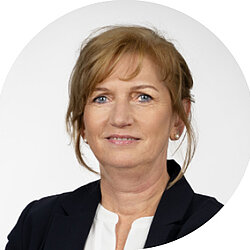One of the most common causes of a broken vertebra is the disease osteoporosis. With this disease, bone strength decreases. But bones also generally become weaker with age and break more quickly. Women are significantly more susceptible than men due to hormonal factors.
What are the symptoms of a vertebral fracture?
Vertebral fractures are extremely painful. Even the slightest movement can irritate the nerves and cause severe pain - regardless of rest, movement or strain. Adopting a relieving posture also causes the surrounding muscles to tense up and movement restrictions are also possible. If the vertebral fracture affects the spinal cord, motor deficits can also occur.
Diagnosis of a vertebral fracture
In an intensive medical examination, the spinal specialist assesses the location of the fracture in the spine and analyzes possible complications. If the posterior edge of the vertebral body is fractured, for example, the edge can press into the spinal canal and onto the spinal cord. In this case, the vertebral body must be additionally stabilized with screws before a kyphoplasty is used for surgical treatment.
Treatment for vertebral fractures: when is surgery necessary?
If conservative treatment options using strong painkillers are not effective, surgery is an option. Kyphoplasty is a proven procedure for vertebral fractures. This minimally invasive operation results in immediate pain relief and targeted realignment of the vertebral body.
Using a catheter, the doctor places a balloon in the corresponding area of the spine and inflates it with saline solution to create a cavity. The cavity is filled with bone cement to restore stability to the vertebra. The cement hardens after a few minutes. The use of the balloon causes the cement to flow into the vertebral body in a targeted manner.
What happens if a vertebral is not treated?
If the fractured vertebral body is not treated, there is a risk that the vertebra will be pressed in and completely compressed by the pressure from above. If the fractured vertebra presses on the bone marrow, neurological seizures can occur.

Claudia Schnitzler-Moos
Secretariat Conservative Orthopedics
- Phone+49 2351 945-2249
- Fax +49 2351 945-2253
- sekretariat.nolte@hellersen.de
Private outpatient clinic
Phone +492351 945-2249
Fax +492351 945-2253
sekretariat.nolte@hellersen.de

Sekretariat Wirbelsäulenchirurgie
Secretariat Spine Surgery
- Phone+49 2351 945-2106
- Fax +49 2351 945-2109
- mvz.neuro@hellersen.de

Andrea Huhn
Secretariat Special Spine Surgery
- Phone+49 2351 945-2551
- Fax +49 2351 945-2552
- sekretariat.meier@hellersen.de

